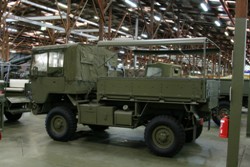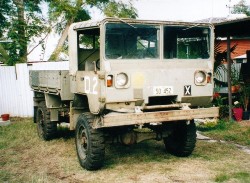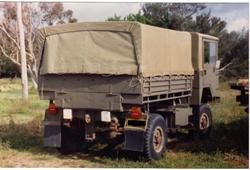 |
|
The XF4 1 Ton Truck Project Before beginning we need to acknowledge a number of sources of information. Mike Cecil for information and his article about these vehicles. Paul Handel for his information, images and research into the topic, as well as the Australian Army and ADE documents that he has given us. The Army Museum Bandiana for information about their three vehicles, as well as those who now own the remainder of these vehicles. In the mid 1960's the Army decided to review their requirements for General Service trucks and recomended that the 3/4 ton Land Rovers be replaced with a 1 ton payload vehicle with as close to 100% australian content as possible. Initial design mockups were of a short square vehicle of forward control configuration and was made of wood. In mid 1969 a pre prototype made of land rover and other components was shown to industry representitives for use as a guide for the basis of their pilot vehicles. International Harvester and Fordesignated Delta and were numbered D1 to D4, and Ford trucks were designated Gamma with G1 to G4. All eight vehicles were put through competitive trials in 1971 - 72 during which they were compared to each other, as well as the model it was intended to replace, the 3/4 ton Land Rover. Much of these trials were undertaken at Monegeeta with over 7000 miles being covered by the vehicles. Costal sand and scrub was tested in August and september 1971 at the flinders naval depot. In November 1971 hot and wet trials were undertaken by the tropicaltrials establishment on one of each vehicle type covering a further 2000 miles. Some unit testing was also undertaken around this time. It was hoped that the vehicle would enter service in 1975. One aspect that does not appear in most histories of these fascinating vehicles is the fact that they were trialed with powered traielrs, quite similar to the trailers that were trialed on the 101 forward control land rover. Despite showing impressive performance, 1and most of the bugs being worked out with further development the project became a casualty of the political climate and the project was wound down in 1973. All eight prototypes are believed to still exist today with one of each on display at the Army Museum Bandiana, while the remainder are in private hands. The ADE Pre-Prototype also resides at the Army Museum Bandiana Some information on this page, as well as further information, can be found in Mike Ceci's article, Remember when ... we built the XF4 Truck? A thankyou also needs to go to Paul Handell who has been of great assistance in providing a large ammount of information on the XF4 project and the vehicles that took part in it. Paul was the one who provided REMLR with a number of documents relating to the project, including comparitive data sheets (From which the vehicle's specifications shown below came from), RAEME Liaison Letter and more. |
|
 |
This is an excerpt from the Norm Darwin's "The History of Ford in Australia" published in 1986. |
| ARN | No. | Manafacturer | Chassis | Engine | Location | Notes |
|---|---|---|---|---|---|---|
| 108-430 | - | ADE | Land Rover | 200ci Falcon motor | Vic |
Mock up made by ADE after initial wooden model. Fitted with land rover
gearbox, chassis and transfer case. ARN Shared with One Ton Amphibious Land Rover Prototype. |
| 179-560 | D1 | International harvester | Delta1 | V304E868474 | Vic | Civilian Hands as with D4 |
| 179-561 | D2 | International harvester | Delta2 | V304E868476 | WA | Owned by Bob Dimer. Tropical Trials Inter. |
| 179-562 | D3 | International harvester | Delta3 | V304E868473 | Vic | Army Museum Bandiana (With wrong rego number) |
| 179-563 | D4 | International harvester | Delta4 | V304E868477 | Vic | Civilian Hands as with D1 |
| 179-556 | G1 | Ford | ADEV179/1 | PJ6959 | WA, Albany | Purchased by 1986 by Mike Conway. About to undergo fulle restoration. |
| 179-557 | G2 | Ford | ADEV179/2 | PJ6965 | Vic | Army Museum Bandiana |
| 179-558 | G3 | Ford | ADEV179/3 | PJ6962 | Vic | In Civy Hands (Same owner as D1 and D4) |
| 179-559 | G4 | Ford | ADEV179/4 | PJ6950 | Vic | In Civy Hands |
|
The Wooden Mockups The fist of the first was a wooden mockup of what the vehicle would look like. The Army Design Establishment (ADE) made this mockup. The wooden mockup also ingrained the concept of a vehicle that could float. The major assemblies consisted of : Mono-construction with integral hull, cabin and body, four speed synchromesh manual transmission and two speed transfer case, a six cylinder gasoline engine and live axle suspension. It was estimated that a cost penalty of 10% would be encountered should the floating concept persued. As a result a second mockup was constructed including many features from the first one, but with a more conventional structure. It was this mockup that was developed further into the working pre prototype. |
|||||||||||||||||||||||||||||||
 The Non Floating Mockup Photo: ADE / Defence |
|||||||||||||||||||||||||||||||
|
ADE Pre-Prototype the ADE then proceeded to construct an intitial vehicle utilising some land rover parts, and other custom built parts. It is an interesting vehicle, and still exists in good condition at the Army Museum Bandiana. |
|||||||||||||||||||||||||||||||
 The ADE Pre Prototype at the Army Museum Bandiana Photo: Cliff Hodgson |
 A front view of the same vehicle. Photo: Cliff Hodgson |
||||||||||||||||||||||||||||||
|
The International Trucks Truck Cargo 1 Ton 4x4 GS, XF4 Manafacturer: International Harvester. The ADE specifications for the two vehicles can be downloaded here. |
|||||||||||||||||||||||||||||||
 D3 at the Army Museum Bandiana |
 Bob Dimer's D2 as it is today, with incorrect ARN plates. |
||||||||||||||||||||||||||||||
 D2's transfer case |
 Inside D2 |
||||||||||||||||||||||||||||||
 Truck D2 whilst on tropical trials |
 Truck D2 whilst on tropical trials |
||||||||||||||||||||||||||||||
|
The Ford Trucks The ford had 6 Cyl Falcon 250 engine While both the ford and International vehicles had the same transfer case with an output for the driven trailer, it seems only the fords were modified to drive the trailers, which makes sense as ford got the contract to make the driven trailers. Truck Cargo 1 Ton 4x4 GS, XF4 Manafacturer: Ford The ADE specifications for the two vehicles can be downloaded here. |
|||||||||||||||||||||||||||||||
 The Ford prototypes lined up at Monegeeta for testing. |
 G1 in the storage yard at Puckapunyal awaiting restoration in the late 1970's. Photo: Cliff Hodgson |
||||||||||||||||||||||||||||||
 G1 post restoration |
 G1 post restoration |
||||||||||||||||||||||||||||||
 G2 at the Army Museum Bandiana |
|||||||||||||||||||||||||||||||
|
Ford was awarded a contract to build three powered and one unpowered trailers, The unpowered version went into limited production. One powered trailer is at the Army Museum Bandiana (photographed below) and another is known to exist in civilian hands.
|
|||||||||||||||||||||||||||||||
 The powered trailer on display at the Army Museum Bandiana |
|||||||||||||||||||||||||||||||
Documents that surfaced in 2009 showed that Land Rover either Tendered, or intended to tender for the XF4 project. More information can be found on the Land Rover DDX-188 page.
|


